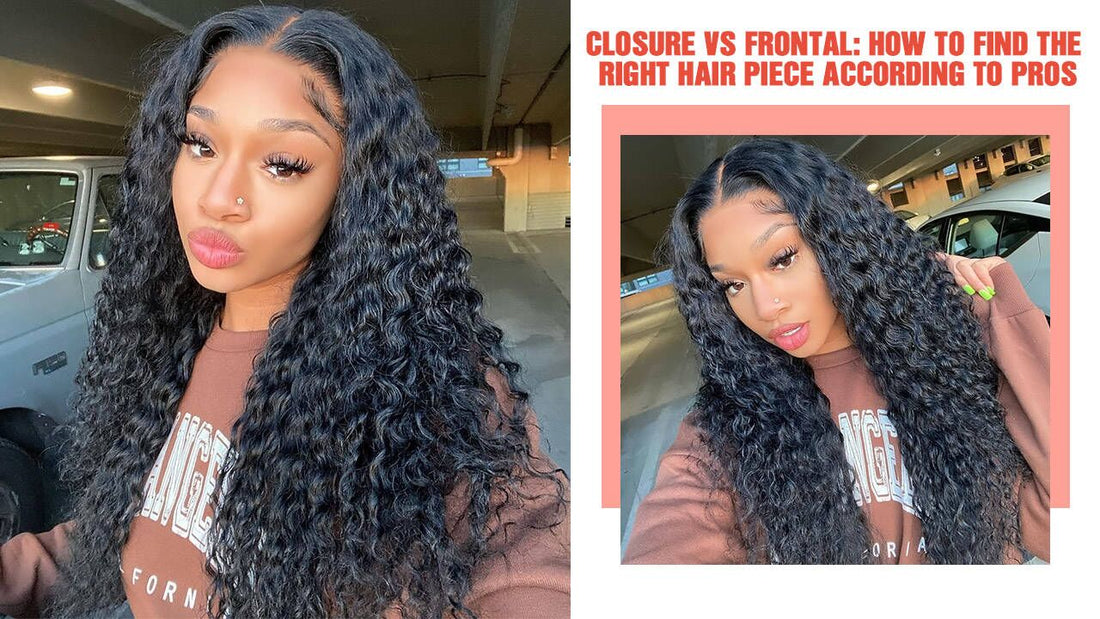
Closure vs Frontal: How to Find the Right Hair Piece According to Pros
Share
Closures and frontals are hair pieces that blend in with your skin, giving the ~illusion~ that your natural hair is growing from your scalp and not a wig or a weave. You can switch up your look while also keeping all of your natural hair tucked away from any heat or style manipulation. But how do you know if you'd do better with a closure vs a frontal? Well, to help answer all your questions, I reached out to Yummie O, founder of Yummy Extensions, to get the lowdown on both options.
What’s the difference between a frontal and a closure?
First things first: A frontal usually covers the entire front area of your head, says Yummie. It goes from ear to ear, so it covers your entire hairline too, making it super versatile. Because a frontal has a lace or silk base that blends the hair piece into your natural skin and hairline, you've got hella style options (think: deep-side parts, half-up ponytails, messy buns). If you get bored with your look after a few days, Yummie says you'll probably do well with a frontal.
That said, there are some drawbacks you've got to consider. Frontals are more expensive than closures—a solid lace frontal ranges from $150 to over $400, while lace closures typically go from $50 to over $120, depending on the type of hair, where you buy it from, and its length.
Closures are v similar to frontals, but they give you fewer styling options. That's not necessarily a bad thing though, especially if you like to stick to one or two looks (I mean, if it isn't broken...). Instead of a strip of lace or silk that goes from temple to temple, a closure is usually a 4x4-inch patch that's placed on the front of the hair piece, says Yummie. Closures are also less expensive than frontals, which might make them more appealing to you and your bank account.
Is it better to get a closure or a frontal?
Well, if you're a complete newcomer to the wonderful world of wigs and weaves, Yummie recommends starting with a closure since frontals can be a lot of work. When you first install a frontal, you've got to do some tweaking to get the natural look you're trying to achieve. You'll need to bleach the knots, tint the lace, so it matches the exact shade of your scalp, and trim, tweeze, and pluck the hairline trim, until it blends in seamlessly.
And even though, yes, you can get a stylist to prep your frontal for you, you'll still need to put in some work at home. Frontals can only be applied with glue, says Yummie, which means you'll still have to deal with re-applying it correctly about once a week and making sure that it blends into your hairline perfectly. On the other hand, Yummie says closures can be applied effortlessly without any glue at all. TL;DR: If you're a beginner (or, tbh, lazy), a closure might be your best option because they're wayy easier to install and maintain.
Can closure or frontal damage your edges?
Unfortunately, yes—but that's only if your closure or frontal isn't applied correctly. According to Yummie, proper placement is a major key. "If you place the hair piece too far behind your hairline, you might end up applying glue to your natural hair, which could cause breakage when you remove the frontal or closure," she says. To avoid this hair emergency, Yummie recommends booking an appointment with an experienced stylist who can help you out.
If you're set on DIY, be sure to apply the glue to your skin—not your hair. You also need to be extra careful when you're removing your frontal or closure. Yummie recommends using a wig glue remover to gently lift the hair piece off of your skin.
How do you take care of a frontal or a closure?
Because closures and frontals are typically made from human hair, you take care of them just like you would your natural hair. Use a wide- toothed comb to smooth out any tangles, apply a leave-in conditioner regularly to keep your hair hydrated, and spritz on a heat protectant spray before you bring any hot tools near your extensions.
And when it comes to taking the glue off your hair piece, Yummie says you should apply 99% ispropyl alcohol on a clean hand towel and gently rub the soaked cloth on the lace until the adhesive is completely removed. Once all of the glue is gone, Yummie recommends deep conditioning the closure or frontal and air-drying it.
If you have a sew-in closure or frontal, be sure to tie a satin or silk scarf around your hairline—not only does this keep your hairline from shifting while you snooze, but it also helps you avoid unwanted flyways and frizz.
